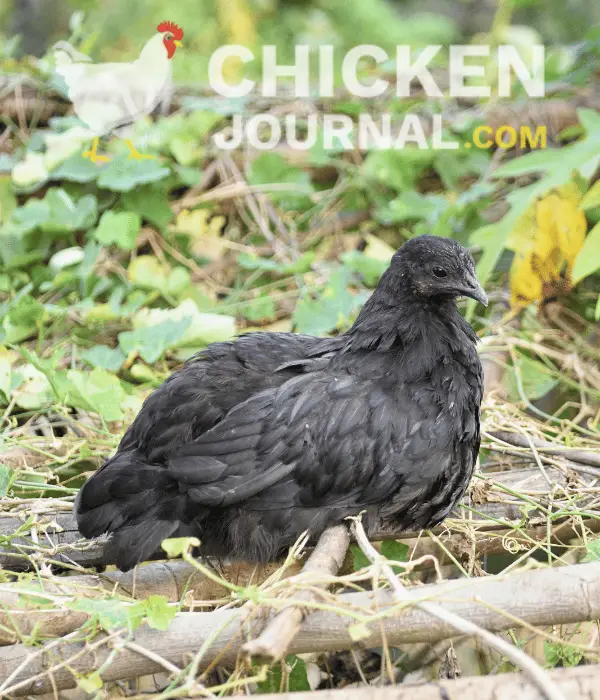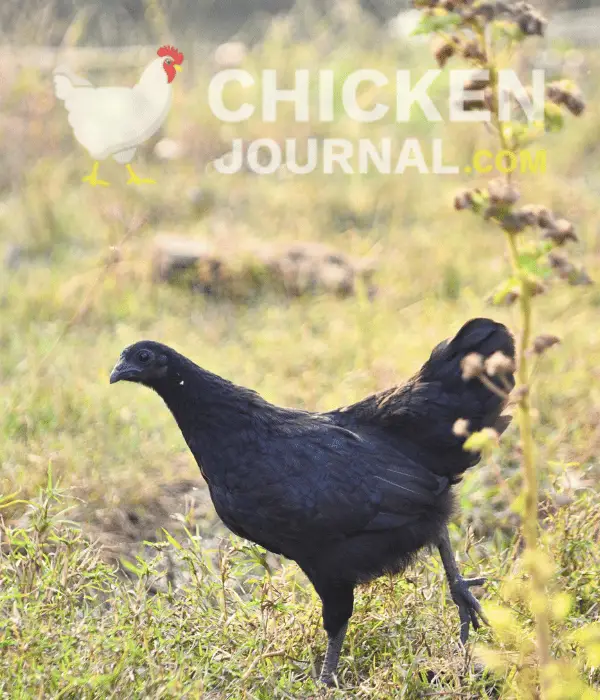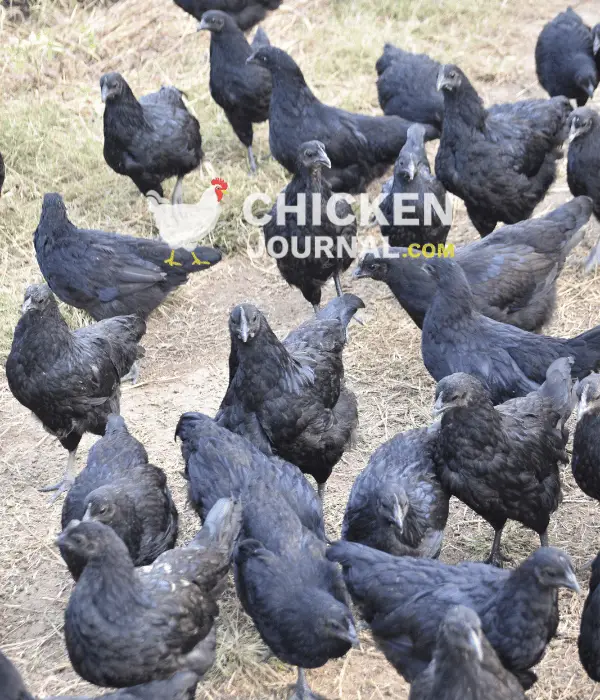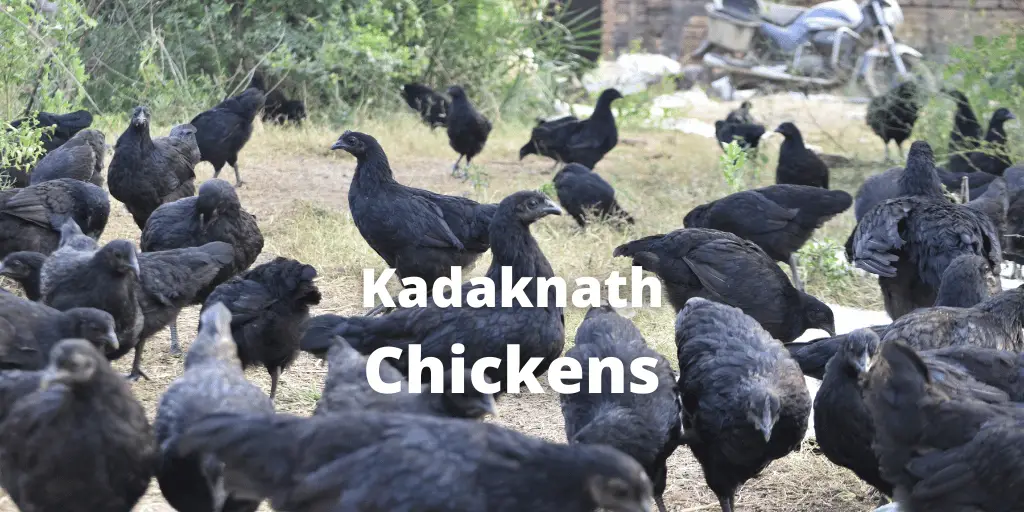The Kadaknath chicken is a unique and fascinating poultry breed that has captured the attention of poultry supporters around the globe.
In this all-around guide, you’ll discover everything there is to know about Kadaknath chickens, including their history, temperament, eggs, size, appearance, characteristics, and the many benefits of raising and breeding them.
Whether you’re a experienced poultry keeper or a starter, this article will provide valuable insights and information to help you make the most of your Kadaknath chicken experience.
Introduction to Kadaknath Chickens
Kadaknath chickens are a rare and exotic breed of poultry native to India, particularly in Madhya Pradesh, Rajasthan, and Gujarat.
They are known for their unique appearance, with black feathers, skin, and even bones. This striking feature has earned them the nickname “Kali Masi,” meaning “black flesh fowl” in Hindi.

Kadaknath chickens are visually intriguing and known for their delicious and nutritious meat, which is high in protein and low in fat.
As a result, they have gained popularity both as a gourmet delicacy and as a healthy alternative to conventional chicken. This chicken breed is similar to the Ayam Cemani chicken breed.
History and Origin of Kadaknath Chickens
The history of Kadaknath chickens dates back thousands of years, with documentation of their existence found in ancient Indian scriptures.
The origins of the Kadaknath chicken can be traced back to the Dhar and Jhabua districts of Madhya Pradesh. They are believed to have been domesticated by the Bhil and Gond tribes of Central India (hilly terrain region), who first reared them for their meat and eggs.
Over time, Kadaknath chickens became integral to the region’s local culture, featuring prominently in rituals and occasions. However, the breed has faced challenges, with populations declining due to habitat destruction and overhunting.
However, efforts have been made to conserve and promote Kadaknath chickens recently, with the Indian government even granting them Geographical Indication (GI) status in 2018.
This designation recognizes the breed’s unique characteristics and historical significance, helping to protect and preserve it for future generations.
Lifespan of Kadaknath Chickens

Kadaknath chickens have a relatively long lifespan compared to other poultry breeds. On average, they can live for up to 12 years, assuming they are provided with proper care and a suitable environment.
However, their productivity in laying eggs and meat production typically declines after 5 to 6 years. As a result, many poultry keepers choose to cull older birds in favor of younger, more productive stock.
Temperament of Kadaknath Chickens
Kadaknath chickens are known to be intelligent and friendly, making them an excellent choice for experienced and novice poultry keepers.
They are generally quite docile and can adapt well to various environments, including urban and rural settings. They love to forage and can find their food if provided the opportunity.
Despite their calm demeanor, Kadaknath chickens can be somewhat flighty, so it’s essential to provide them with a secure and spacious living area to prevent escapes.
However, they can be susceptible to stress, so providing them with a peaceful and stress-free environment is important.
Appearance of Kadaknath Chickens
The most striking feature of Kadaknath chickens is their entirely black appearance. Their feathers, skin, beak, and even bones are all black or dark gray, making them easily distinguishable from other poultry breeds.
This unique pigmentation is due to a genetic condition called fibromelanosis, which causes the overproduction of melanin throughout the bird’s body.
In addition to their black coloration, Kadaknath chickens have a sleek and slender build, long legs, and narrow bodies.
They possess a small, single comb and wattles, which are also black. In addition, their eyes are usually black or dark brown, adding to their striking and exotic look.
Characteristics of Kadaknath Chicken

Kadaknath chickens are known for their hardiness and adaptability, making them well-suited to various climates and living conditions.
They are hardy and can tolerate extreme temperatures, making them well-suited for rearing in hot and humid climates.
They also resist many common chicken diseases, making them a low-maintenance breed. In addition, they have a strong immune system, which helps them resist common poultry diseases and infections.
This resilience makes them an excellent option for novice poultry keepers who may not have extensive experience in managing chicken health.
Keysmith chickens are also good foragers, which can help reduce feed costs and make poultry keeping more sustainable and self-sufficient.
They are highly prized for their meat, which is tender, flavorful, and low in fat, making it a popular choice for health-conscious consumers.
Kadaknath Chicken Hen Eggs Laying Age, Count, Egg Size, and Egg Color
Kadaknath hens begin laying eggs at around 6 to 7 months, which is later than many other chicken breeds.
They lay an average of 80 to 120 eggs each year. The eggs are small to medium, with a light-brown or cream-colored shell.
It’s important to note that while Kadaknath chickens are mainly raised for their meat, their eggs are also nutritious and can be a valuable addition to your diet.
However, other breeds may be more suitable if egg production is your primary goal. They are also considered a delicacy in some parts of India.
Size and Weight of Kadaknath Chickens

Kadaknath chickens are medium-sized birds, with adult males (roosters) weighing between 2.5 to 3 kilograms (5.5 to 6.6 pounds) and adult females (hens) weighing between 1.5 to 2 kilograms (3.3 to 4.4 pounds). Their slender build and long legs contribute to their unique, elegant appearance.
Kadaknath Baby Chicks Appearance and Cost
Kadaknath chicks are born with black downy feathers and beaks, and their dark pigmentation intensifies as they grow. Both hens and roosters have a single-type comb.
As this is a rare and unique breed, Kadaknath chicks can be pricier than those of more common chicken breeds. The average price of Kadaknath chicks cost around $1 each.
Prices can vary depending on factors such as the quality of the breeding stock and the availability of chicks in your area.
Kadaknath Rooster Vs. Hen
Some differences between Kadaknath roosters and hens can help you distinguish between the sexes.
Roosters usually have a single comb and wattle, long tail feathers, and a more pronounced spur on their legs than hens do.
Kadaknath roosters tend to be more vocal and exhibit more territorial behaviors, such as crowing and guarding their flock.
Roosters from Kadaknath have muscular bodies, while hens have a circular body. The hens are quiet and love to forage near their owners.
Benefits of Raising and Breeding Kadaknath Chicken

1. Unique and attractive appearance: The striking black coloration of Kadaknath chickens makes them an eye-catching addition to any poultry flock.
2. Nutritious and delicious meat: Kadaknath chicken is a popular choice for health-conscious consumers because of its high in protein, low in fat, and distinctive flavor.
3. Adaptability and hardiness: Kadaknath chickens are well-suited to various climates and living conditions, making them an excellent choice for novice and experienced poultry keepers.
4. Disease resistance: Their strong immune system helps Kadaknath chickens resist common poultry diseases and infections. However, proper immunization is most important.
5. Efficient foraging: Kadaknath chickens are skilled foragers, which can help reduce feed costs and contribute to a more sustainable poultry-keeping system.
Problems Associated with Raising Kadaknath Chicken
- Late egg-laying age: Kadaknath hens begin laying eggs later than many other breeds, which can be a disadvantage if egg production is your primary goal.
- Moderate egg production: Kadaknath chickens lay a moderate number of eggs yearly, so they may not be the best choice for those seeking high egg yields.
- Flightiness: Kadaknath chickens can be somewhat flighty, requiring a secure and spacious living area to prevent escapes. They need open and long runs to forage and play.
- Higher cost: As a rare and unique breed, Kadaknath chickens can be more expensive to purchase and raise than more common breeds.
Health Benefits of Kadaknath Chicken Meat – Culinary Benefits
Kadaknath chicken meat is highly prized for its delicious taste and numerous health benefits. It is low in fat and high in protein, making it a healthy choice for those trying to maintain a healthy diet.
Additionally, Kadaknath meat contains essential amino acids, vitamins, and minerals to contribute to overall health and well-being.
Culinary enthusiasts appreciate the unique flavor and tender texture of Kadaknath chicken meat, which can be used in various dishes, from traditional Indian cuisine to modern fusion recipes.
The meat is also known to cook quickly and evenly, making it a versatile and convenient ingredient for home cooks and professional chefs.
Frequently Asked Questions About Kadaknath Chicken
What is special about Kedaknath chicken?
Kadaknath chicken is a unique breed known for its entirely black appearance, delicious and nutritious meat, and adaptability to various climates and living conditions.
What to feed Kadaknath chicken?
Kadaknath chickens can be fed a diet similar to other poultry breeds, consisting of a balanced mixture of grains, proteins, and green vegetables. They are also efficient foragers, which can help reduce feed costs.
Also read: Complete guide on feeding chickens.
Why is Kadaknath chicken black?
The Kadaknath chicken’s black coloration is due to a genetic condition called fibromelanosis, which causes the overproduction of melanin throughout the bird’s body.
Where to get Kadaknath chicken?
You can purchase Kadaknath chickens from reputable breeders or online poultry marketplaces. Choose a reputable source to ensure you’re getting healthy, high-quality birds, and do your research.
Where can I buy Kadaknath chicken?
You can purchase Kadaknath chicken from reputable breeders or online poultry marketplaces. Research a reputable source to ensure you get healthy, high-quality chicks and chickens.
How to identify pure Kadaknath chicken?
Pure Kadaknath chickens can be identified by their black appearance, including their feathers, skin, beak, and bones. You can also consult an experienced poultry keeper or veterinarian for assistance in identifying pure Kadaknath chickens.
Conclusion – Why Kadaknath Chicken is a Unique Breed
Kadaknath chicken is a unique and fascinating breed, known for its striking black appearance, delicious and nutritious meat, and adaptability to various environments.
Whether you’re an experienced poultry keeper or just starting your journey, raising Kadaknath chickens can be a rewarding and enjoyable experience.
With their numerous benefits and intriguing history, it’s no wonder that Kadaknath chickens have captured the hearts and imaginations of poultry enthusiasts worldwide.
While some challenges are associated with raising them, the benefits outweigh the drawbacks. Overall, Kadaknath chickens are a breed worth considering for anyone interested in poultry farming.


